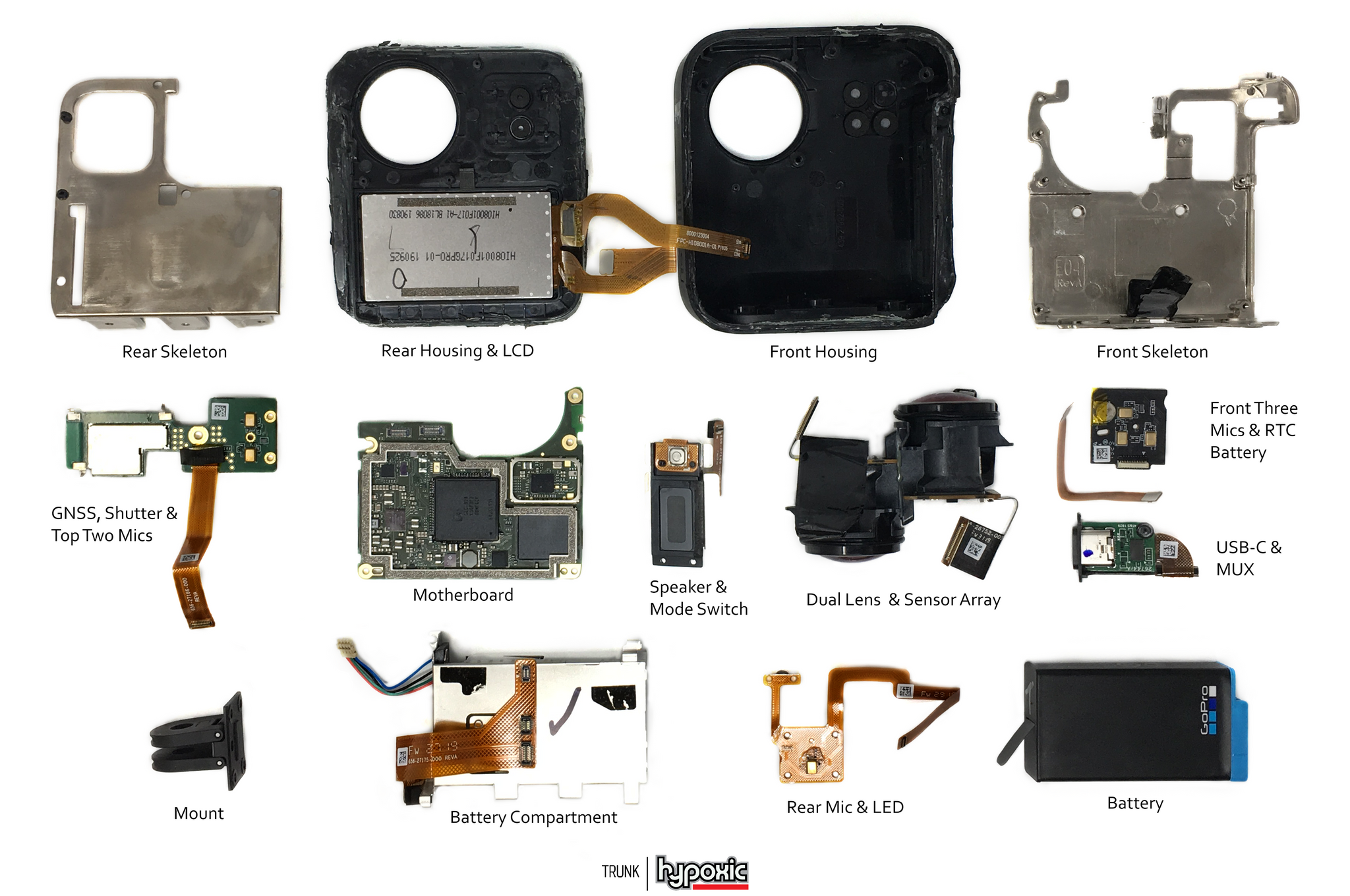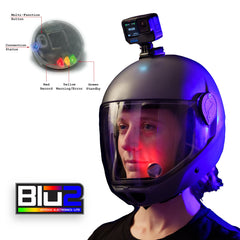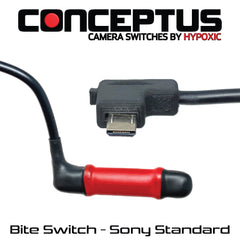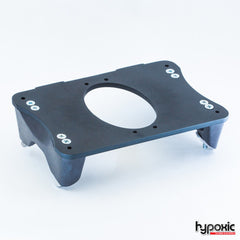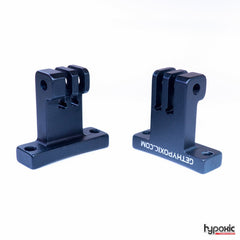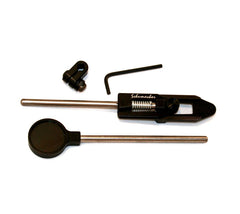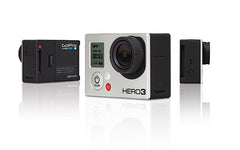GOPRO MAX Teardown
Posted by Mark Kirschenbaum on
It's been a while since we performed a physical teardown of a GOPRO, but with the innovations in the new GOPRO MAX, a full teardown is warranted. This camera will allow you to get stabilized, immersive shots, with minimal post editing. Many other blogs have already reviewed the MAX's functionality, so we'll focus on the internal wizardry that makes it work.
System's Components
- Housing The ABS plastic housing has a rubberized overmolding. It consists of two halves, sealed together by some sort of epoxy. For the camera's 16ft waterproofness, both lenses, and all the screw holes, have washers sealing up the body. Membranes cover the microphone, and a "breathing" port.
- Skeleton The front and rear skeletons are heat staked to the ABS housing and then affixed to the base of the camera by three screws. It provides structure, frame grounding, and shielding for all the electronics.
- Top PCB | GNSS On the top of the camera resides the GNSS antenna and controller, two microphones, and the shutter switch. It also contains the "e-compass", a Bosch BMM150.
- Motherboard Houses primary processing. This section is expanded upon down below.
- Speaker & Mode Switch Interestingly the speaker itself has a built in waterproof membrane.
- Dual Lens & Sensor Array Two Nittoh lenses and Sony IMX577 modules are glued together. One of the two arrays have the Bosch IMU populated which gives the acceleration information for the system. Unlike other cameras, the Inertia Measurement Unit is not placed precisely in the center of the imaging sensor. The dual lens array screws into the front ABS housing in multiple places. Unlike other plastic cameras, it does not screw into the skeleton.
- Front Microphone PCB Contains the front side's left, right, and top microphones as well as a status LED and backup battery for the real time clock.
- USB-C PCB This board houses the USB-C connector and Pericom Databus Mux. It may allow for HDMI out over the SBU pins of the USB type-C port. It's an unpublished part.
- Battery Compartment Standard GOPRO HERO battery implementation.
- Rear Mic Interestingly, given all the microphones in this camera, the rear/LCD side only has a single mic. This singularity is most likely due to it recording in Ambisonic Audio as well as Left & Right streams.
Code Names & IDs
Codename: Coconuts
Model Number: 51
Model: H19.03
Motherboard

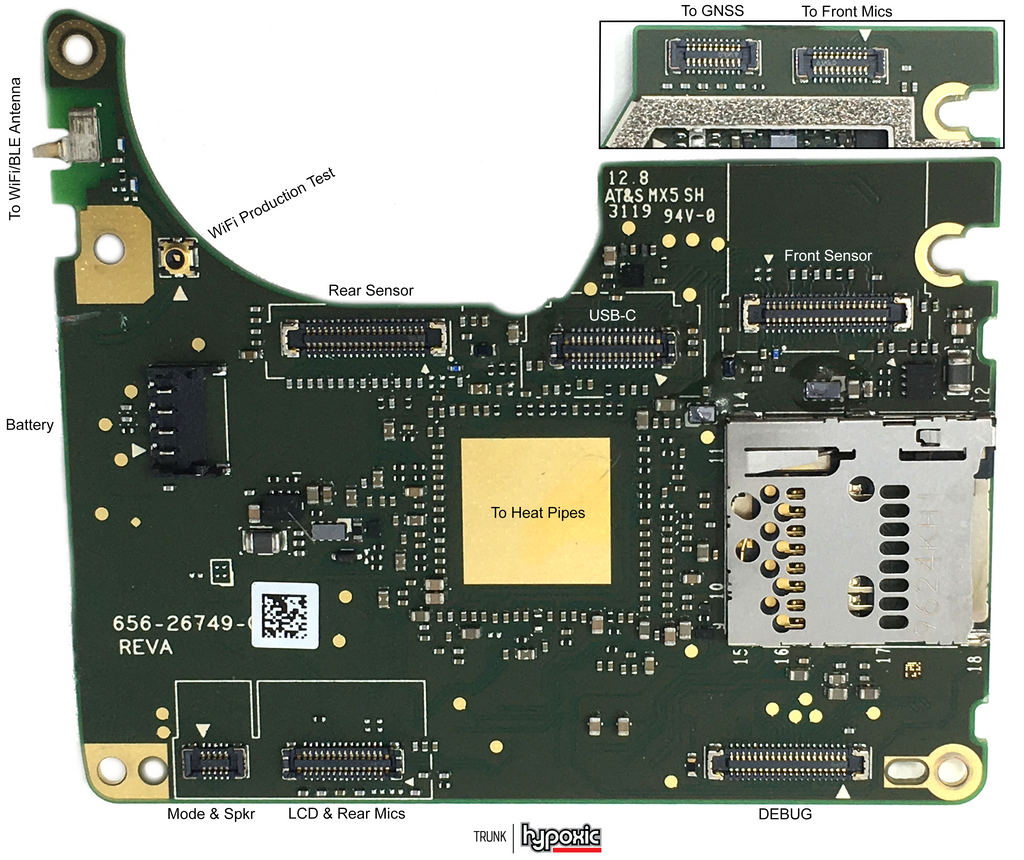
GOPRO MAX's Electronic's Bill of Materials
Similar to the GOPRO HERO8 Teardown, the GOPRO MAX does not have too many surprises. The most notable changes are the Bosch BMM150 e-compass, the Sony IMX577 sensors, and the DSP Group DBMD7. Also the six microphones are now available for ambisonic sound.
| Socionext SC2000A custom (GP1) |
Imaging Processor |
| Samsung K3QF3F30BM-FGCF |
2GB DRAM Chip Mobile LPDDR3 SDRAM 16Gbit 256Mx64 1.8V/1.2V 256-Pin FBGA (Multi-die on the SC2000A) |
| DSP Group DBMD7 | A high performance advanced voice control and machine learning SoC with custom Gopro Inc. defined AWE Core parameters. |
| Single Accelerometer / Gyro pair 6-axis sensor. Two new direct interrupts into the GP1. | |
| "E-Compass" 3-axis digital geomagnetic sensor. Located on GPS PCB. Used for horizon leveling. | |
| Qualcomm QCA9377 |
High performance, low power single-stream 11ac MU-MIMO and Bluetooth 5 in a single chip solution. |
| Sony IMX577 |
2x Sensor 12.3MP 1/2.3-Type 7.857mm, 4056 x 3040 pixels @ 60fps@10bit, 43fps @ 12bit |
| Apple MFI | For Wi-Fi Accessory Configuration (WAC). |
| UBlox UBX-M8030-CT | GPS Receiver u-blox M8 GNSS chip, WL-CSP47, Standard grade |
| Active Semi ACT9150 |
PMIC (Power Management IC) for Socionext. Power supply and charging. |
| Active Semi ACT88326 | PMIC Dedicated 0.9v regulator for VDDCore and possibly LDDR of GP1. |
| FocalTech FT3306DMB | Touch Panel Controller. Uses FT6306 driver. |
| Holitech LCD Sitronix ST7796S controller |
272RGB X 480 dot 262K Color TFT |
| Microchip SAM L22 | USB-C PD / Accessory Sentinel / Battery authentication / RTC / Reset Handler. Always "on" 64Kb Encrypted bootloader & app Still authenticates Battery and SHA204 as before. |
| Pericom PI3USB9281 | Protecting against bad chargers, detecting power, USB pin muxing. Controlled via SAML22. |
| Pericom PI3DBS126I2ZTFE | Multiplexer switch 12 Gbps, possibly 6 Channel, & USB-C Databus MUX. Likely custom or non-documented part. Controlled via the SAML22. |
| ONSemi FUSB302BUCX | USB Type-C PD controller. Controlled via the SAML22. |
| Nittoh Z600 Lens | 2x 194° dual fisheye lenses |
| 8GB eMMC 5.1 HS400 | |
| Unknown supplier MARKING: NC06 9817 3012 |
6x MEMS Audio Microphones |
Battery
Li-Ion 4.4V 1600mAh
Part: SPCC1B
GOPRO Fuel Gauge Type: 1
Maxim MAX17201 "Stand-Alone ModelGauge m5 Fuel Gauge with SHA-256 Authentication"
Manufactured by Amperex Technology Limited
20 byte static NONCE, SHA-256 encryption to 32 byte result. Open to side channel analysis. Simple repeat attack per unit.
Audio System
There are six MEMS microphones on the GOPRO MAX that most likely all feed into the DSP Group's DBMB7. This DSP gets loaded with a customized Gopro plugin which defines how the system processes the sound before it gets streamed into the GP1. We've heard the effects of this processor in freefall as you can actually hear people screaming on exit. This is something we've never heard before in our 17 years of jumping. This system also allows the GOPRO MAX to record in ambisonic audio for later post processing by their player and encoder. Ambisonics is over my head at the moment, but looks like the DBMB7 processes this on board.
It seems they have not turned on the 'wake-on-voice' feature with the GOPRO MAX. This would allow you to turn on the GOPRO MAX by saying "Gopro Turn On." WOV (wake on voice) is hooked up in the SAM L22 so this feature may happen in the near future.
Construction
We were a bit taken back as to this camera's construction. At first glance, the GOPRO MAX is not as hardened as other models. Granted, if this camera is dropped, a lens will be ruined so a cracked LCD or dinged body is the least of your worries. No matter what, the GOPRO MAX must be handled with care.
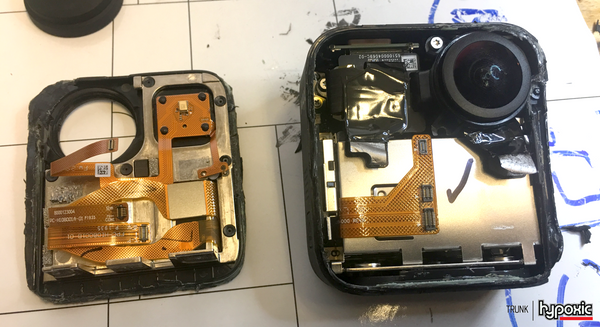
Above is how the camera looks when just the halves are separated. There is no way to dissect this camera without destroying the case. We carefully cut through the glued intersection and still cracked the LCD. As you can see, the skeleton is fused to the ABS plastic housing via several heat stakes. Also seen is the rear side, with the LCD, which only has a single microphone.
Interestingly, the imaging sensor's heat pipes connect to the battery compartment and to the rear skeleton. This may be a method to keep the battery warm in cold climates as well as to suck heat away from the battery during operations.
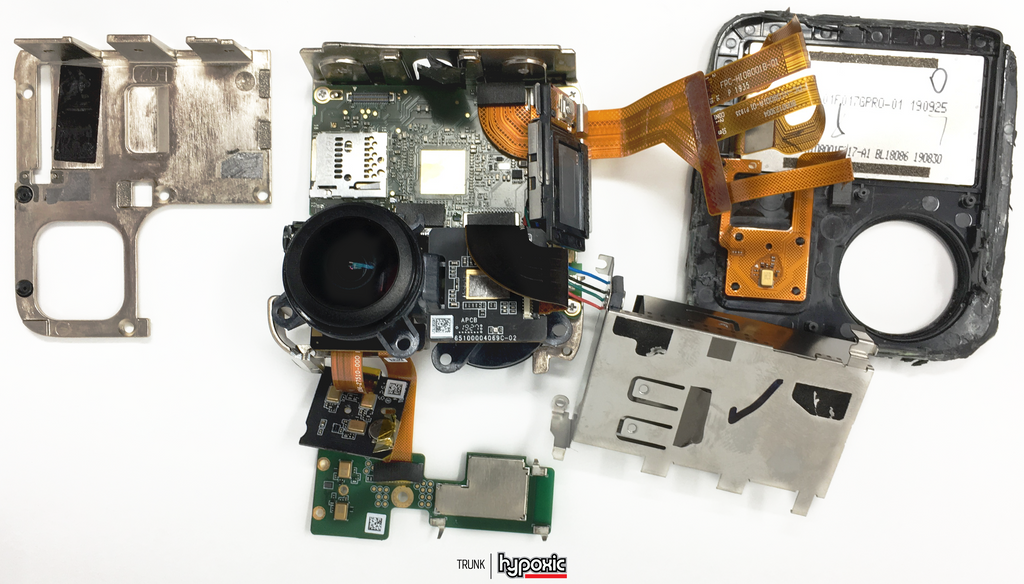
Above is the GOPRO MAX still in working conditions. It's now perfect for a test device.
Modifying
There is no good way to open up and modify the GOPRO MAX. The modifications will have to be done in firmware or via a properly "keyed" accessory off of the USB-C port. No aftermarket accessories are planned for this camera and the lack of a Analogix ANX7816 makes HDMI out not a possibility via a hacked media mod. The Pericom databus mux may have enough channels to pass HDMI over USB-C so a standard dongle with a 0x2672 SVID 0x3 or 0x8 PID may work.
Firmware can be tweaked, but it is risky as a ROM loader doesn't seem to be accessible once this camera is bricked. For those that are interested, you can see this camera's RTOS and Linux logs on Hypoxic's Github repo.
The GOPRO MAX and the GOPRO HERO8 share much of the same code base and likely they share the same RTOS and Linux code base.
Final Thoughts
The GOPRO MAX is a great tool to add to your camera bag. The horizontal stabilization will enable you to get gimbal-like footage when mounted on unsteady objects.
Due to its construction, the camera, LCD, and lenses must be handled with utmost care. I would suggest getting GOPRO Plus or some sort of aftermarket warranty on this camera if you are using it for extreme sports.
Electronically, there is nothing too surprising in its design. All of the stabilization and encoding comes from some real tricky firmware. I highly suggest you read David Newman's article on the new GOPRO 360 format as well as watch Abe Kislevitz's video on the horizontal stabilization. The ambisonic audio and clarity in windy environments is pretty incredible technology that we'll see more of in the near future.
Be sure to check out our HERO8 Teardown
Thank You,
-Trunk

